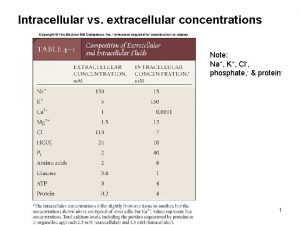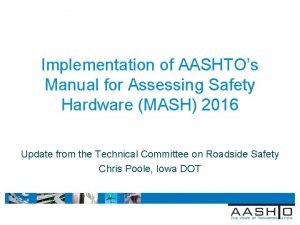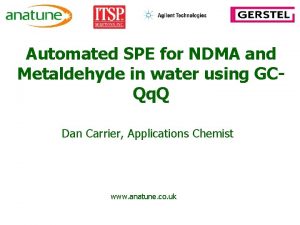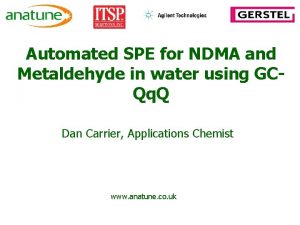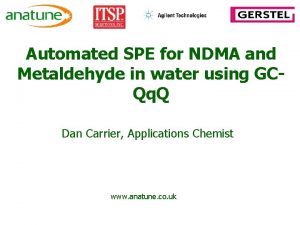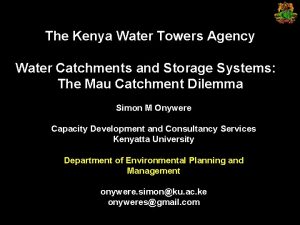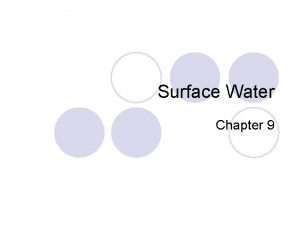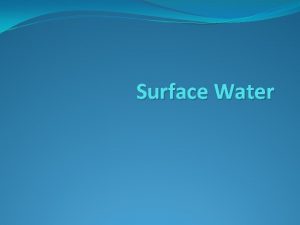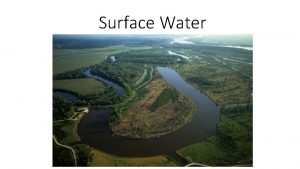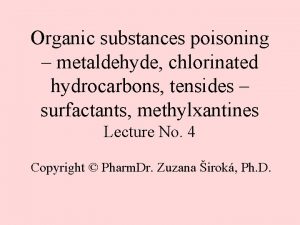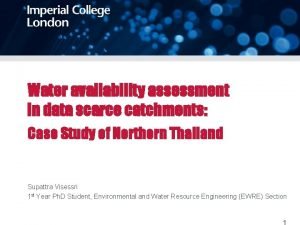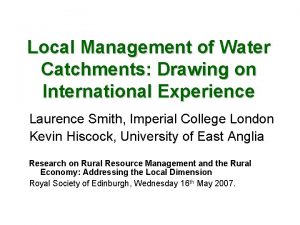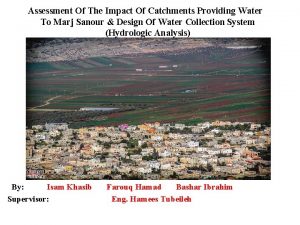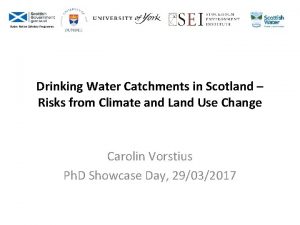Assessing Metaldehyde Concentrations in Surface Water Catchments and















- Slides: 15

Assessing Metaldehyde Concentrations in Surface Water Catchments and Implications for Drinking Water Abstraction Alemayehu Asfaw, Ph. D student - University of Sheffield James Shucksmith, Senior Lecturer – University of Sheffield Andrea Smith, Process Engineer, Severn Trent Water Ltd Katherine Cherry, Catchment Management Advisor, Severn Trent Water Ltd April 16, 2015 Vienna

Outline • Background • Metaldehyde in surface water – Grab sampling • Managing mataldehyde – Catchment management – Abstraction management • Auto-sampler data collection • Catchment characteristics Vs metaldehyde • Conclusions and Future work

Background • • • Metaldehyde, active ingredient in slug control Heavily used in agriculture (6000 – 10000 tons every year in UK) Application period between September – December Following periods of heavy rainfall, reaches water sources Can not be removed by existing treatment process

Metaldehyde in Surface Water Grab sampling ok ro ins B a R. R R. Leam m Lea tche R. I Why Sampling? • Understanding where and when high levels of metaldehyde occur in the catchment • Identify high risk areas and target catchment management work R. L ook Samples are taken on a monthly basis increasing frequency at high risk times d Br • eam n dfor a R. R When and where are samples taken? • Sample locations are chosen to capture the influence of different tributaries - Grab sampling Points

Metaldehyde in Surface Water R Leam source to conf Rains Brook B s n ai R. R R Leam conf Rains Brook to conf R Itchen R R. L rook rd B adfo R. R Grab sampling data eam n tche R. I Willes Meadow Bridge R. Leam m a. Le - Grab sampling Points

Metaldehyde in Surface Water • General trend of metaldehyde application generated from grab sampling data • Week numbers starting from first week of September Rainfall event at each week causes different rate of metaldehyde flux in to water bodies.

Managing Metaldehyde • Effective catchment management strategies. – Identify high risk areas – Target catchment management work and engage with stakeholders • Drinking water abstraction management to reduce the amount of metaldehyde finding its way into drinking water systems. – understand which hydro-meteorological characteristics of the catchment trigger the peak migration of metaldehyde to surface waters – assess the relationship between measured metaldehyde levels and catchment characteristics • Fine scale datasets required to link rainfall events to fate and transport of metaldehyde

Data Collection • Auto-sampler locations in the River Leam catchment ok R. R R. Leam d Br R. L dfor a R. R eam chen R. It am. Le ro B s n Rai ook

Auto-sampler data • Triggered when there is rainfall • 24 slots - Hourly samples • Five events (3 and 5 day) EU limit in drinking water

Flow Vs Metaldehyde • Flow variation triggered mainly by direct runoff has shown some correlation with metaldehyde concentration Rate of runoff generations from different parts of the catchment impacts flow Vs metaldehyde correlation

Rainfall Variability • Assess the impact of rainfall variability on Metaldehyde generation Metaldehyde risk map Radar rainfall (1 Km 2 and 5 minute resolution) Rainfall High risk Area Low risk Area River High risk area Auto-sampler location

Rainfall Variability Comparison of rainfall on high risk areas to low risk areas • Significant rainfall variability has not been observed during data collection events. However, rainfall variability needs to be considered in the development of prediction model.

Rainfall Vs Metaldehyde 36 hours

Conclusions • • • Conventional grab sampling data is highly variable – Doesn’t provide full understanding of the occurrence of metaldehyde in the water environment – Can mislead on the prediction of potential risk of exposure Grab sampling routines need to be guided by initial assessments using high resolution data and risk map assessments (information on when and where to take samples). Surface water abstraction can be managed to avoid the entrance of peak metaldehyde concentrations into drinking water system with no significant impact on abstraction volumes Future work • Auto-sampler starting time – Use detailed weather prediction data • Turbidity data • Use in-catchment grab sampling data, land use map, and recommended metaldehyde application and application information to predict application dose • Develop prediction model to inform abstraction decisions based on ‒ Rainfall intensity/duration ‒Duration between rainfall events ‒ Direct runoff ‒ Pesticide application

Thank you
 Water and water and water water
Water and water and water water Intracellular k concentration
Intracellular k concentration Ways to address grammar in the writing classroom ppt
Ways to address grammar in the writing classroom ppt Beginning teachers (career stage 1)
Beginning teachers (career stage 1) Strengths in reading
Strengths in reading Assessing a new venture's financial strength and viability
Assessing a new venture's financial strength and viability Assessing leadership and measuring its effects
Assessing leadership and measuring its effects Module 4 topic 1 assessing and managing risk
Module 4 topic 1 assessing and managing risk Module 4 topic 1 assessing and managing risk
Module 4 topic 1 assessing and managing risk Curved surface area of cone
Curved surface area of cone Lateral surface area of the triangular prism
Lateral surface area of the triangular prism Btec sport level 3 unit 3
Btec sport level 3 unit 3 Unit 18 assessing children's development support needs p1
Unit 18 assessing children's development support needs p1 Assessing need for hrd
Assessing need for hrd Manual for assessing safety hardware
Manual for assessing safety hardware Cultural dynamics in assessing global markets
Cultural dynamics in assessing global markets

